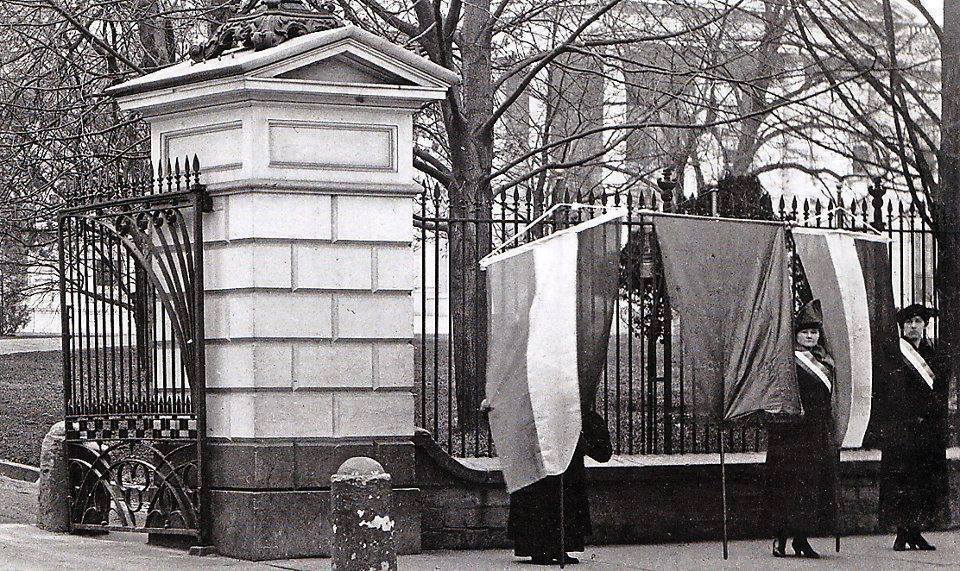
Today in Feminist History is our daily recap of the major milestones and minor advancements that shaped women’s history in the U.S.—from suffrage to Shirley Chisholm and beyond. These posts were written by, and are presented in homage to, our late staff historian and archivist, David Dismore.
January 12, 1917: Today was a very good—though quite frigid one—for the “Silent Sentinels” of the Congressional Union for Woman Suffrage.
They are standing next to the White House gates with suffrage banners and their tricolor standards from 9 a.m. until 5:30 p.m. each day until President Wilson endorses the Susan B. Anthony (woman suffrage) Amendment to the U.S. Constitution, then uses his considerable influence to get it approved by a Congress controlled by his fellow Democrats. It can then go to the state legislatures, where it will need approval by 36 out of 48.
Though the idea of picketing the President was only suggested three days ago, and implemented day before yesterday, this colorful protest has now stirred interest not just citywide, or even nationwide, but around the world.

Among the many donations that came in today was one from Dora Lewis, of Philadelphia, who is spending the winter in Shanghai, China. Even there she heard of the picketing, and immediately wired $300 to help with expenses. Though certainly the most distant donor, she was not the most generous of the day. That honor went to Mary Burnham, also of Philadelphia, who gave $1,100. Sophie G. Meredith of Richmond, Virginia, gave $350.
Not all donations came in the form of money. Two gentlemen stopped by briefly to give boxes of candy to picketers as a sign of their support, and an elderly woman donated many hours on the picket line, even though the “official” pickets were initially reluctant to accept her offer because she wasn’t dressed warmly enough.
She told the Congressional Union members: “For 20 years I have been in the civil service… They advance the men over the women there. You women of the Union exposed the civil service two years ago, and now I want to work with you.” She was then warmly accepted into the ranks and spent the rest of the day as a 13th Sentinel.
The day’s most appreciated non-monetary donation arrived in the form of a large shipment of oilcloth raincoats. They’re big, heavy, strictly practical and not at all in the typical style of women’s rainwear. But they certainly seem capable of fulfilling their intended purpose of protecting the pickets from even the worst rainstorms that the city will inevitably throw at them in what may be a long-term protest.
Of course, the hats with the wide brims at the back may make passersby wonder if the White House is under siege by suffragists or being protected by the Fire Department, but the Congressional Union’s purple, white and gold banners, surrounding others bearing the message, “Mr. President, What Will You Do For Woman Suffrage?” should clear up any doubts.
Though the temperature dropped from 22 to 17 degrees during picketing hours, and strong winds increased the chill, President Wilson continues to warm to the picketers. When he encountered them the first time, day before yesterday, he remained expressionless and looked straight ahead. Yesterday, he gave them a slight smile as he passed through the gate. Today he gave a big smile, and tipped his hat.
Whether this daily escalation means he’s slowly being converted into a supporter of the Anthony Amendment or just having progressively better mornings on the golf course is not known, but it seems a good sign.
According to Mary Gertrude Fendall, “Officer of the Guard” for today’s detail: “We are glad that the President smiled on us. We appreciated also the invitation extended to us yesterday by the President to come into the East Room out of the cold shivering weather. Perhaps we have succeeded in making the President take notice of us in such a way that he may help get us the Federal suffrage amendment at this session of Congress.”
It should be noted that the pickets politely turned down the President’s invitation to warm up inside, and stayed at their posts for the full day.
Future plans of the pickets are ambitious. It was announced today that on March 4th, the date of President Wilson’s second inaugural, there will be not just the usual twelve pickets (three on each side of the East and West gates of the White House) but a thousand protesters surrounding the entire Executive Mansion. If so, this will not be the first time suffragists have tried to impress President Wilson with great numbers.
Just a little less than four years ago, on March 3, 1913, Alice Paul coordinated the National American Woman Suffrage Association’s massive suffrage march and pageant here the day before Wilson’s first inauguration. She’s still in D.C., and as dedicated as ever to the cause of “Votes for Women.” She now heads the Congressional Union for Woman Suffrage, and has been freed from the constraints of the more traditional National American Woman Suffrage Association.
Wilson is still President, and though women have won full voting rights in 11 states and the Territory of Alaska, they are still denied equal suffrage in 37 states. So today, just as four years ago, the struggle goes on, only using new and more militant methods.





